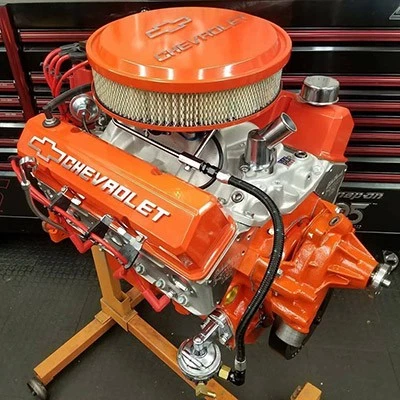Is there truly “no replacement for displacement” with a big block? Or should you go small with a mighty mouse engine? Debates about a big block engine versus small block rage on.
The question has been asked for more than 60 years, ever since General Motors introduced its first big block V-8 engine in 1958.

This block comes fully prepared with all the necessary accessories, from carburetor to plugs and wires.
For owners of most late-model cars, the choice of engine blocks in new production cars ended in 2009. That’s when GM stopped offering its last big block—the Gen VII Vortec 8100—for new showroom vehicles.
Chevy’s performance division still offers big block engines. But those come with a stern notice: for competition only. They are not considered street legal due to emission laws. But there are still plenty of aftermarket options - opens in new window or tab. on eBay Motors for those wanting a big block crate engine.
What Is a Big Block Engine?
Check to make sure a large 350 HO engine will fit in the engine bay.
An engine “block” is a loose term. Its meaning is up for grabs. Some enthusiasts will argue that it’s all about the physical size and weight of the engine structure, regardless of displacement. Others say that the real difference between big block and small block engines has absolutely everything to do with displacement.
Big block engines usually have displacements great than 400 cubic inches. Anything smaller than that means it’s a small block.
Small blocks attain higher revolutions faster due to shorter strokes.
The term big block engine also refers to the overhead valve design - opens in new window or tab.. They are notable for their larger bore (the diameter of the pistons) and longer strokes (the distance a piston travels). These measurements yield more displacement.
Big blocks have greater low-end torque and overall power—producing a pleasing engine note and a feel of power from behind the wheel.
Today’s smaller engines use stronger metals and castings—due to advances in material science and manufacturing. Their lighter weight results in higher fuel efficiency and better power-to-weight ratios, and a lower center of gravity.
Shopping Advice: Big Block Engine vs Small Block

This block is missing necessary components like the intake manifold and distributor.
Not all engine blocks on eBay are created equal. Some vendors offer just the block engine, while others also install the intake manifold, distributor, spark plugs, and wires. You have to be careful to compare similar setups.
Car builders can massage higher outputs from the same engine by swapping out various parts. So you aren’t restricted to only buying a crate motor as-is from an established manufacturer.
For example, some tuners alter the camshaft, thus changing performance specs. There are risks. Changes can mean less reliability.
How Big Can a Big Block Be?
Straight out of a crate, GM Performance offers a ZZ572/720R Deluxe with 727 horsepower and 680 pound-feet of torque at 4,900 pm. This is the largest displacement engine in its big series.
Alternatively, you could opt for the little brother ZZ572/620 Deluxe that drops down to 621 horsepower and 645 foot-pounds at 4,200 pm.
Meanwhile, the highest horsepower that GM offers from a small block crate is the LT5’s 755 horsepower and 715 pound-feet of torque. This is the engine that comes with the 2019 Corvette ZR1.
Newer technology is allowing smaller engines to outmuscle the big boys. Nonetheless, when you drop down to the LS class of motors, only one of the LSX454 engines can produce more horsepower than the larger mills. The LSX 454 makes 627 horsepower and 586 pound-feet of torque at 5,100 pm.
The lowest rated small block motor from Chevrolet currently is its 350/265 base small block that cranks out a modest 265 horsepower and 351 pound-feet of torque at 3,300 pm.
Big Engines from the Detroit Three
We offer these Chevy engine examples for comparison. But of course, Chevrolet wasn’t the only Detroit manufacturer offering big blocks. Ford historically produced a 460 cubic inch big block for Lincolns and a smaller 429 cubic inch for Thunderbirds.
But when the era of muscle cars subsided, big block engines were mostly reserved for heavy-duty trucks like the Ford F-150. Like Chevy, Ford still offer some big blocks for competition only. They are not street legal.
Chrysler offered big block "wedge" engines from 1958 through 1978. Wedge engines came in displacements from 350 through 440 cubic inches. The 361 wedge was produced for its trucks as well, and made 305 horsepower.
A few import brands also got into the game. But they used American engines shipped to Europe and then returned to the US under the hood of cars like the De Tomaso Pantera - opens in new window or tab., Jensen Interceptor - opens in new window or tab., and of course AC Cobra.
Today’s crate engine - opens in new window or tab. prices ride up and down mostly based on the power output. So how fast you want to go probably depends on how much you want to blow. eBay Motors has options for every level of expense and performance.
Share your feedback
This article is meant to provide general guidance only. Automotive maintenance, repair, upgrade, and installation may depend on vehicle-specifics such as make and model. Always consult your owner's manual, repair guide for specific information for your particular vehicle and consider a licensed auto-care professional's help as well, particularly for advance repairs.


